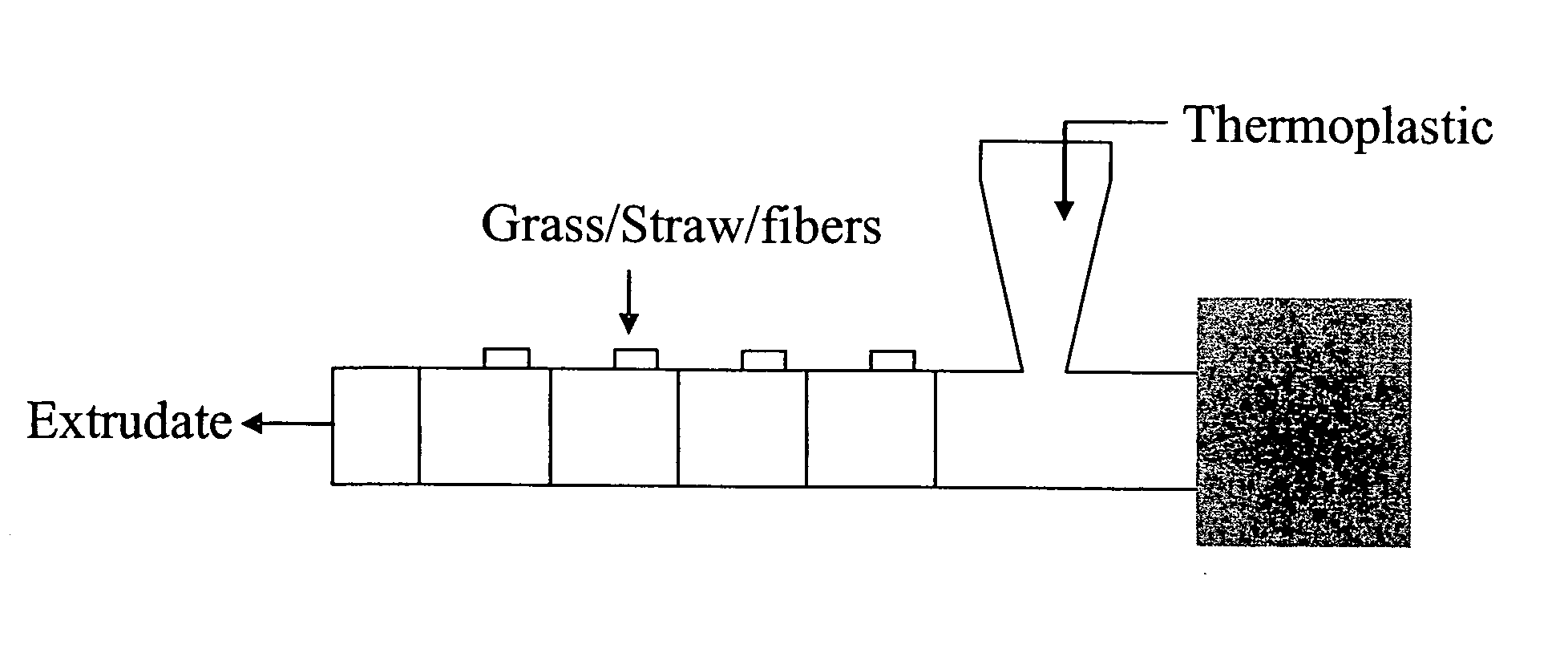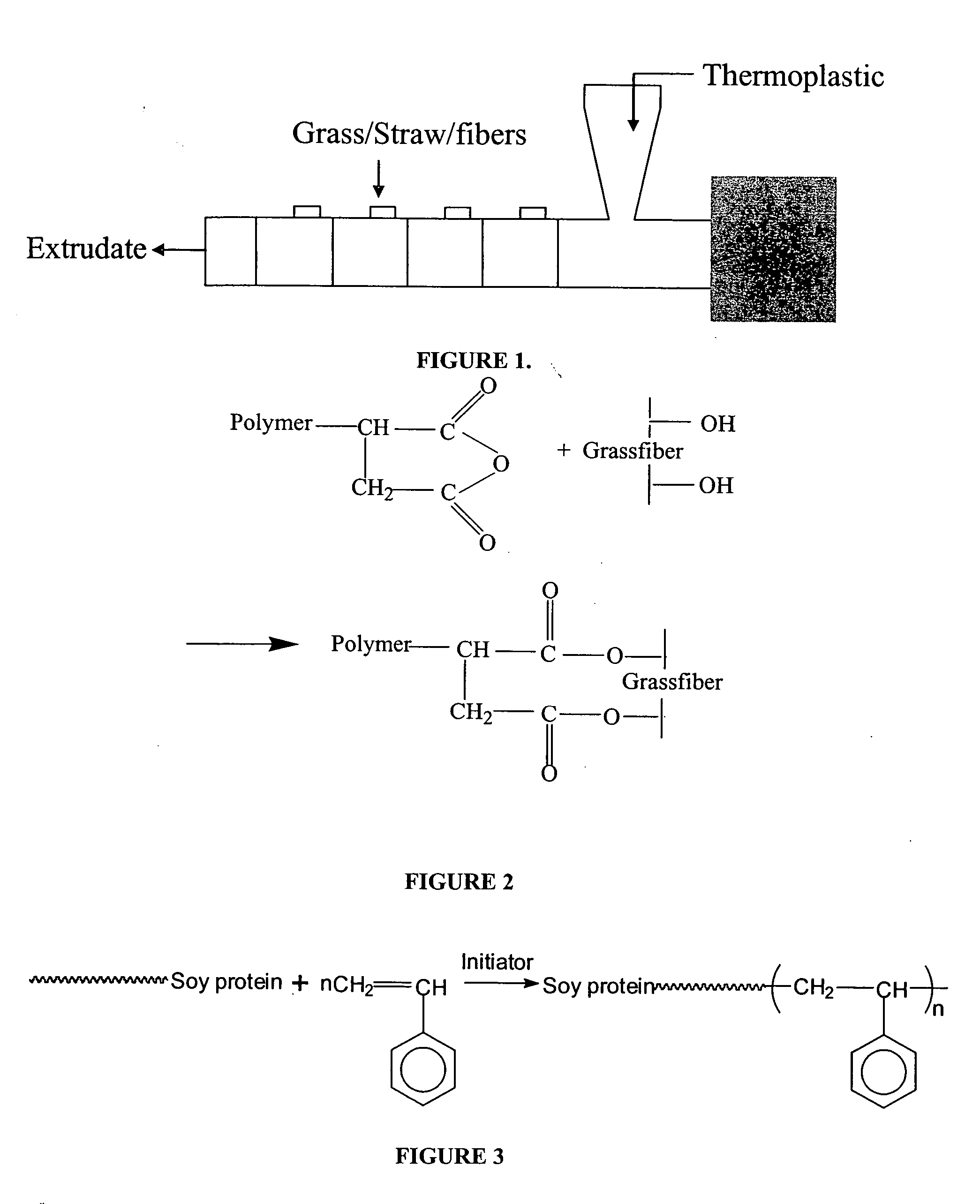Cellulosic biomass soy flour based biocomposites and process for manufacturing thereof
a technology of cellulosic biomass and biocomposites, which is applied in the direction of peptides, filament/thread forming, plant/algae/fungi/lichens ingredients, etc., can solve the problems of low strength and high moisture absorption of soy protein plastic, and have never been produced using a sheet molding compounding lin
- Summary
- Abstract
- Description
- Claims
- Application Information
AI Technical Summary
Problems solved by technology
Method used
Image
Examples
example 1
Soy Based Bioplastic (Soy Protein Plastic and poly(tetramethylene Adipate-co-terephthalate) Reinforced with Varying Content of Indian Grass Fiber
[0092] Soy flour was obtained from Archer Daniels Midland (ADM), Decatur, Ill. Glycerol was supplied by J.T. Baker Phillipsburg, N.J. Eastar Bio co-polyester (poly(tetramethylene adipate-co-terephthalate) (PTAT) was supplied by Eastman Chemical Co., Kingsport, Tenn. Indian grass was used “as received” from Smith, Adams & Associates LLC, Okemos, Mich.
[0093] Soy flour, fiber and biodegradable polymer were dried at 80° C. under vacuum for 16 hours before processing. After drying, soy flour was blended with glycerol to the ratio of 70 / 30 using a kitchen aid blender. The mixed material was then fed into the extruder, a ZSK-30 Werner and Pfleiderer Twin-screw Extruder (L / D=30) with a 6 zone barrel, with processing temperatures of 95° C., 105° C., 115° C., 125° C., 130° C., 130° C. and screw speed of 100 RPM. The soy flour based polymer was re-...
example 2
[0095] Soy based bioplastic (soy protein plastic and polyester amide) reinforced with varying content of Indian grass fiber. Soy flour was obtained from Archer Daniels Midland (ADM), Decatur, Ill. Glycerol was supplied by J.T. Baker Phillipsburg, N.J. Polyester amide was supplied by Bayer Corp., Pittsburgh, Pa. Indian grass was used “as received” from Smith, Adams & Associates LLC, Okemos, Mich.
[0096] Soy flour, fiber and biodegradable polymer were dried at 80° C. under vacuum for 16 hours before processing. After drying, soy flour was blended with glycerol to the ratio of 70 / 30 using a kitchen aid blender. The mixed material was then fed into the extruder, a ZSK-30 Werner and Pfleiderer Twin-screw Extruder (L / D=30) with a 6 zone barrel, with processing temperatures of 95° C., 105° C., 115° C., 125° C., 130° C., and 130° C. and a screw speed of 100 RPM. Soy protein plastic was re-extruded with polyester amide with a processing temperature of 130° C. and a screw speed of 100 RPM. Th...
example 3
Alkali Treatment of Indian Grass Fiber
[0099] Chopped grass with a length of 20 mm was treated in 5-wt % and 10-wt % sodium hydroxide (J.T. Baker) solutions in water. After the appropriate soak time, the fiber was rinsed with distilled water until the pH of the rinse solution stabilized at 7. After storage at room temperature for four days, the alkali treated and raw fibers were dried under vacuum at 80° C. for 16 hours. The structure, morphology and thermal properties of raw and alkali treated fibers were studied by the use of X-ray photoelectron spectroscopy spectrum (XPS, Physical Electronics 5400 ESCA), Fourier transform infrared spectrum (FTIR, Perkin Elmer system 2000 Spectrometer), environmental scanning electron microscopy (ESEM, Phillips Electroscan 2020) and thermogravimetric analysis (TGA, TA 2950), respectively.
[0100] The surface treatment (such as alkali) conditions of grass have been optimized. Digital pictures of grass fiber showed a reduction in the fiber size and ...
PUM
| Property | Measurement | Unit |
|---|---|---|
| Temperature | aaaaa | aaaaa |
| Temperature | aaaaa | aaaaa |
| Temperature | aaaaa | aaaaa |
Abstract
Description
Claims
Application Information
 Login to View More
Login to View More - R&D
- Intellectual Property
- Life Sciences
- Materials
- Tech Scout
- Unparalleled Data Quality
- Higher Quality Content
- 60% Fewer Hallucinations
Browse by: Latest US Patents, China's latest patents, Technical Efficacy Thesaurus, Application Domain, Technology Topic, Popular Technical Reports.
© 2025 PatSnap. All rights reserved.Legal|Privacy policy|Modern Slavery Act Transparency Statement|Sitemap|About US| Contact US: help@patsnap.com



